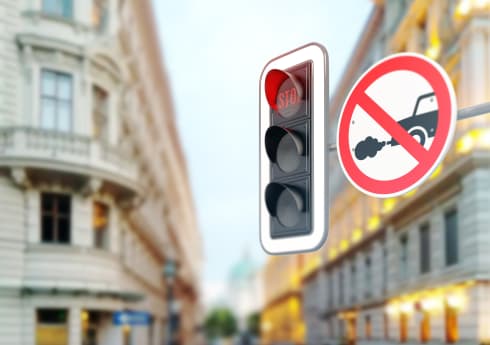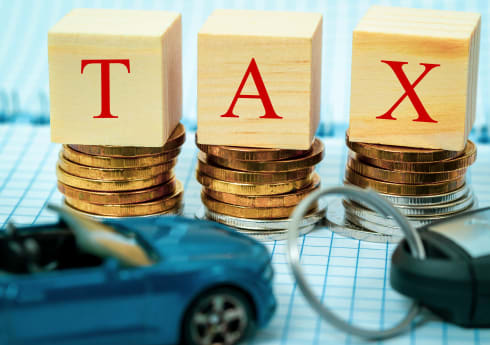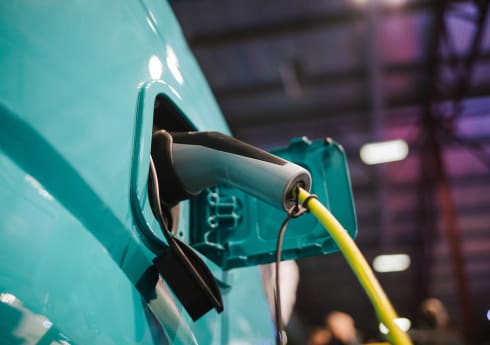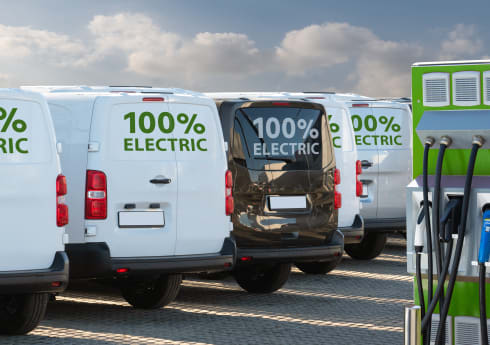The impact of ULEZ on London businesses
In this guide, we’ll explain ULEZ, how it works, how it impacts you and ways to future-proof your business.

What is ULEZ?
ULEZ stands for Ultra Low Emission Zone, which covers London. It aims to reduce air pollution by charging drivers of high-polluting vehicles to enter a designated area.
The ULEZ in London was also designed to encourage the use of low-emission vehicles and transition businesses and road users towards a time where electric vehicles become the norm.
ULEZ benefits
- Improves air quality in London by reducing the number of polluting vehicles on the roads.
- Encourages the use of low emission vehicles and promotes the development of cleaner technologies.
- Reduces harmful nitrogen dioxide (NO2) emissions by 45% in the zone.
- Could also reduce the number of premature deaths caused by air pollution in London.
Where does ULEZ cover?
The zone currently covers all London boroughs and the City of London. At present, it does not include the M25 motorway.
How much does it cost to enter a ULEZ?
Vehicles that don’t meet the ULEZ emission standard and aren’t exempt, have to pay a daily charge of £12.50 to enter the designated area. Vehicles included are:
- Cars
- Motorcycles
- Vans
- Specialist vehicles (up to and including 3.5 tonnes)
- Minibuses (up to and including five tonnes)
Exceptions apply to lorries, vans and specialist heavy vehicles (all over 3.5 tonnes) and buses, minibuses and coaches (over five tonnes).
These vehicles don’t have to the pay a ULEZ charge, but they’ll need to pay London’s LEZ charge if they don’t meet the Low Emission Zone (LEZ) emissions standard.
What other charges apply in London?
Be aware, the ULEZ is not the only charge applicable to drivers entering London.
The Congestion Charge zone applies to central London and is in effect between 07:00-18:00 Mon-Fri, 12:00-18:00 Sat-Sun and bank holidays. There’s no charge between Christmas Day and New Year’s Day bank holiday (inclusive). The cost is £15 a day if you drive between the times and on the days mentioned above.
Exemptions from the Congestion Charge:
- Two-wheeled motorbikes (and sidecars) and mopeds.
- Emergency service vehicles, such as ambulances and fire engines, which have a taxation class of ‘ambulance’ or ‘fire engine’ on the date of travel.
- NHS vehicles that are exempt from vehicle tax.
- Vehicles used by disabled people that are exempt from vehicle tax and have a ‘disabled’ taxation class.
- Vehicles for more than one disabled person (for example Dial-a-Ride) that are exempt from vehicle tax and have a ‘disabled’ taxation class.
The Low Emission Zone (LEZ) was set up to encourage the transition to cleaner vehicles away from heavy polluting diesel vehicles. The LEZ applies 24/7 every day of the year, with no exceptions.
Most vehicles meet LEZ standards, but those who don’t have to pay the following:
- £100 for vans or specialist diesel vehicles (over 1.205 tonnes unladen weight up to 3.5 tonnes gross vehicle weight) or minibuses (up to five tonnes) which do not meet Euro 3 standards.
- £100 for HGVs, lorries, vans and specialist heavy vehicles over 3.5 tonnes as well as buses/minibuses and coaches over five tonnes which do not meet Euro 6 (NOx and PM) standards, but meet Euro 4 (PM).
- £300 for HGVs, lorries, vans and specialist heavy vehicles over 3.5 tonnes as well as buses/minibuses and coaches over five tonnes which do not meet Euro 6 (PM).
If you drive a HGV over 12 tonnes in Greater London at any time you will need a HGV Safety Permit to show your vehicle meets the Direct Vision Standard (DVS). Otherwise, you’ll be subject to a penalty charge notice.
How to pay the ULEZ charge
If you drive into a designated Ultra Low Emission Charge and your vehicle is not ULEZ-compliant, keep in mind you can pay by midnight on the third day following your journey or up to 90 days in advance. Failing to pay on time can get you a Penalty Charge Notice (PCN).
Pay the £12.50/day charge on the TfL website. If you set up an Auto Pay for any Congestion Charges and ULEZ charges, the amount you owe will be drawn automatically from your account every month.
Is my vehicle ULEZ compliant?
According to TfL, nine in ten cars seen driving in outer London are already ULEZ-compliant cars.
ULEZ-compliant vehicles are those that meet the ULEZ emissions standards.
- Petrol cars and vans: Euro 4 emissions standard (generally those registered with the DVLA after 2005).
- Diesel cars and vans: Euro 6 emissions standard (generally those registered with the DVLA after September 2015).
The easiest way to find out if your vehicle is ULEZ-compliant is to use the TfL ULEZ checker.
What vehicles are exempt from ULEZ?
Some drivers and vehicles can get an exemption or a discount on charges. Including:
- Vehicles for disabled people
- NHS patient payments (people too ill to attend appointments)
- Taxis
- Minibuses for community transport
- Wheelchair accessible private hire vehicles (PHVs)
- Historic vehicles
- Specialist vehicles like farming, military, mobile cranes and excavators
You can check the full list and details, plus make an application, on the discounts and exemptions on TfL.
Prepare your business for ULEZ
Every business can be affected by these laws. Even if it’s not impacting you now, it will eventually.
That means it’s important to prepare so it doesn’t cause your business problems later. We can find the best solutions for your business to help you cope with the ULEZ.
Future-proof your business with ULEZ compliant vans
If you have an older van, you’ll be paying up to £3,000 a year to work in the zone.
To get around that, you can think about hiring vans that are ULEZ-friendly. You can hire a fleet for a fraction of the cost of buying and get the cost saving benefits thrown in on top of that.
You can check out our guide to ultra-low emission zone vans to help you make a choice. Or compare the market right now for the best deal.
Transition to electric vehicles (EVs)
There’s a great choice of electric cars, motorcycles and vans on the market. And you can get government grants for electric vehicles, which can help your business with the cost of moving away from diesel and petrol vehicles.
One common tactic for businesses is to hire EVs. That way you can use them flexibly for as long as you need, without having to fork out for the full upfront cost.
Then you can use the EVs for as long as you want. All without having to face emissions charges, which can mount up over the course of a year.
Use money-saving telematics solutions
Telematics devices and solutions can be used to:
- Plan different routes for your drivers to avoid the ULEZ
- Re-route them in real-time if they run into traffic
- Monitor drivers to make sure they’re avoiding charges
- Track your drivers’ use of petrol or diesel
Fleet telematics systems have a range of data on driving behaviours, which you can use to reduce fuel consumption. Plus, there are telematics systems that can integrate your business fuel cards for extra convenience and savings.
Telematics helps because you can’t always avoid emissions charges. But with these systems integrated into your fleet management, you can limit them. And all while driving in a more environmentally friendly way. You can check out our guide to telematics for more details.
Get eCargo bikes
eCargo bikes are bicycles that can carry small payloads and use an electric motor. Plus, they have no tailpipe emissions. If you’re a delivery company, you can use these for your fleet. While they can’t carry huge loads, they’re very effective around the busy streets of London.
You may even be eligible to apply for a grant for an eCargo bike. The Department for Transport (DfT) has made £2 million of funding available to help companies purchase eCargo bikes.
In summary
Whether businesses like it or not, ULEZ charges are here to stay so the best thing your business can do is be prepared.
You can adopt a few strategies to limit the charges for your business. One of your best options is to invest in market-leading technologies that can support your business. Like telematics, EV hire or charging points for your EV fleet. You can get a variety to help you avoid, and deal with, ULEZ charges.
The good news is they’re at great value, too! Compare the market to discover the latest EV technology within your budget. Stay informed about your fleet, charge points and everything in between.
At iCompario, we’ll help you find the best solutions for your business. Whether it’s vehicle tracking and telematics you’re looking for, EV solutions, fuel cards or other B2B services.



